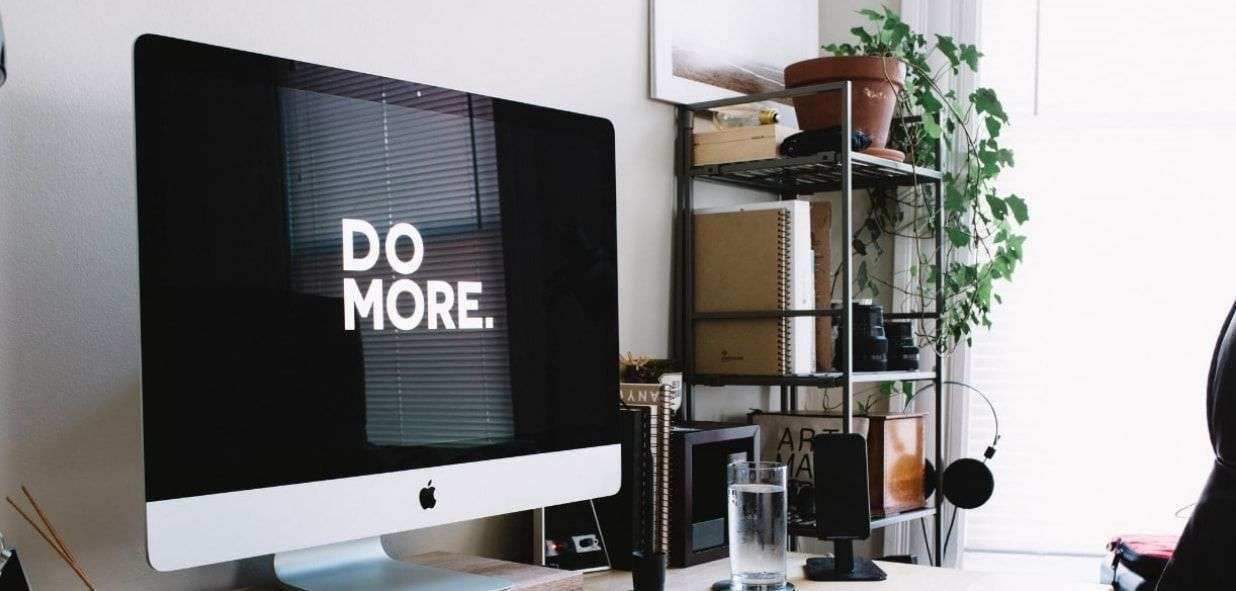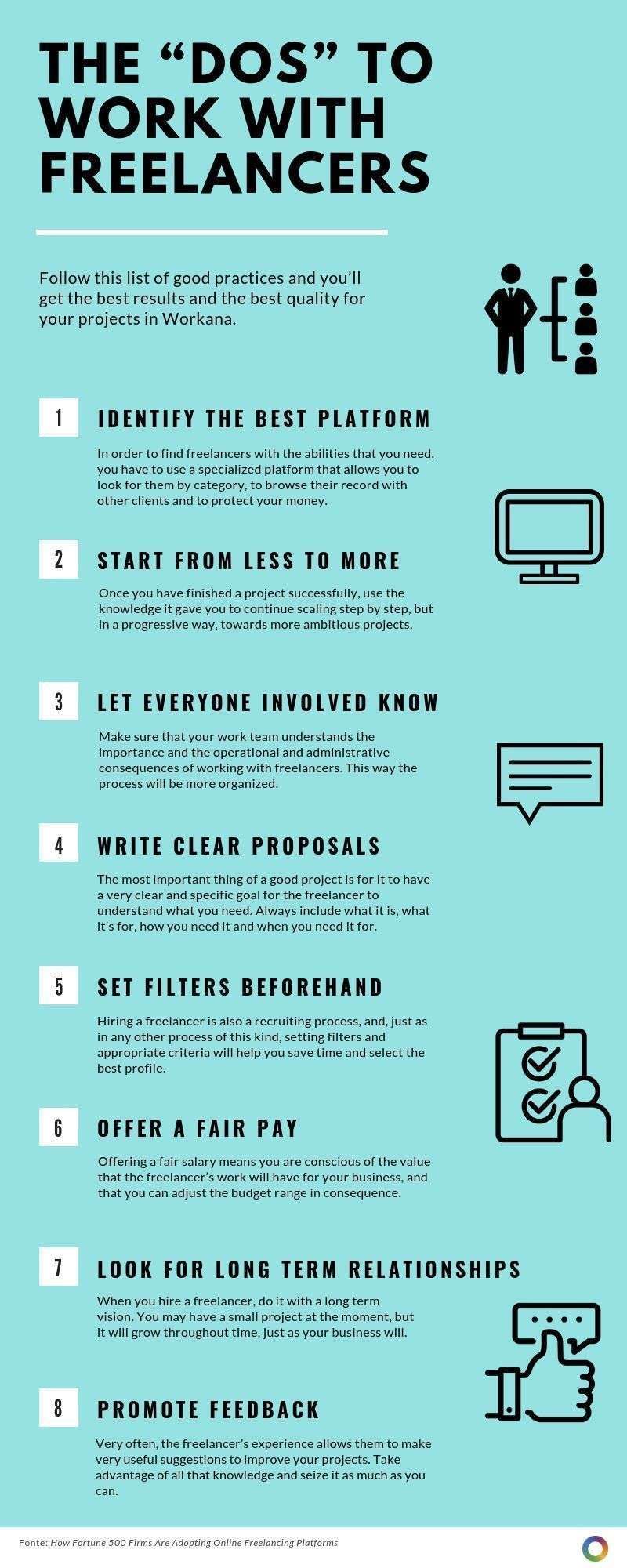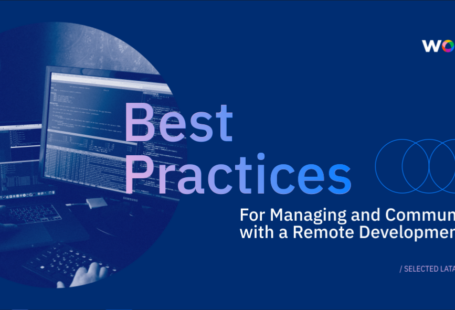One of the best decisions you can make in order to keep your business competitive and growing is to hire freelancers.
It doesn’t matter if you’re starting an entrepreneurship, or if you want to scale your small business, or even if you’re just looking to migrate to a friendlier paradigm workplace within your business. For any type of business, some of the main advantages of working with freelancers are:
- Growth. In Workana you’ll find an amazing availability of the talent you’re looking for, which will allow you to create teams of remote work and land new projects to expand yourself in a record time.
- Savings. Hiring by project or by hours instead of having a permanent employee allows you to save a lot in hiring costs and fixed salaries. It also encourages to work by goals, which, according to Randstand consultants, is the most efficient way to work.
- Flexibility. Freelancers move like fish in the sea in a commercial environment characterized by change and a constant evolution. They work on simultaneous projects, they have a more diverse experience and they can offer a wider and more assertive vision of the solutions that your company needs.
Regardless of the many proven advantages of hiring freelancers, some entrepreneurs and well established business people still don’t trust remote work.
In other cases, the decision of hiring one or more independent professionals is taken without acknowledging the good practices that should be carried out and the frequent errors that should be avoided. This causes bad experiences and makes the decision makers close themselves to the opportunity of continuing to grow with this model.
For this reason, in order for you to take advantage of all its benefits, it is extremely important that you know what to do as well as what not to do when hiring freelancers.
In this article we will share with you the conclusive dos and don’ts from Oxford University study. The study explores the way that some businesses from the Fortune 500 group are successfully adopting the use of freelancing platforms.

The “Dos”
Let’s start with the dos or also known as good practices of hiring freelancers:
1. Identify the best platform
It’s not easy to find remote professionals with good references and with the exact abilities that you need. You need to find a specialized platform that allows you to look for them by category, browse their record with other clients and protect the investment you make in each hiring process.
Workana meets all these features and not just that, it is also the biggest and most trusted remote-work platform in Latin America.
2. Start from less to more
Surely, there are hundreds of tasks and projects in your company that you could delegate to a freelancer or to a remote team. Identify them and select a small project with a moderate reach.
Once it has been completed successfully, use the knowledge that the experience gave you to continue escalating step by step, but in a progressive way, towards more ambitious projects.
The most important thing is that you take the first step as soon as possible, even if it’s a small step. You can give more impact to your logo’s design, add a function to your website, or hire a virtual assistant to help you with that extra work load, among many more possibilities. The best part of it? In Workana you can create a free project and start receiving offers from freelancers with no obligation.
3. Let everyone involved know
Make sure that your team understands the importance and the operational and administrative consequences of working with freelancers. For instance, it is necessary to inform the financial and human resources departments that you will integrate remote workers and that they have to adjust the organization chart or the corresponding payments. If you have questions about a certain topic or if you wish to learn more, you can contact us, we’re here to help you.
4. Write clear and complete proposals
The most important aspect of a project is for it to have a very clear and specific goal so that the freelancer understands exactly what you need. If you can, always include details regarding what it is, what it’s for, how you need it and when you need it for. For example:
“I need to redesign my logo (what it is) because I want it to reflect more vitality and freshness (what for). I would give you a PDF file with our current logo as a reference, but I need to receive an editable file in Photoshop (how you need it). The required deadline is 3 days (when you need it for).”
You can see more proposal examples that our clients have posted by clicking here.

5. Set criteria and filters beforehand
Hiring a freelancer is also a recruiting process, and, just as in any other process of this kind, setting filters and appropriate criteria will help you save time and select the best profile.
For example, you can include specific forms in your proposal, or notes to see if the freelancer is paying attention, to see if they follow instructions or if they have provable experience in similar projects.
6. Offer a fair pay
Remember that when you are paying an independent employee you are making an investment, and this should be congruent with the service you expect to receive.
Offering a fair salary means you are conscious of the value that the freelancer’s work will have for your business, and that you can adjust the budget range in consequence.
7. Look for long term relationships and experts that provide added value
When you hire a freelancer, do it with a long term vision. You may have a small project at the moment, but it will grow throughout time, just as your business will.
It is always best to build a trusted remote employee team with the ability to adapt and grow along with you. So, when you are selecting the freelancer you want to work with, take into account the rest of their abilities, even if you don’t need them now.
8. Stay open to change and feedback
Very often, the freelancer’s experience allows them to make very useful suggestions to improve your projects or even to propose creative new strategies to keep growing. Take advantage of all that knowledge and seize it as much as you can.
The Don’ts
Now, let’s take a look at the don’ts when independent workers join your projects. Knowing these details will allow you to have a better experience once you start incorporating them into your frequent collaborators team.
1. Don’t look away from the guarantee of a job well done
There are many tools to ensure engagement, motivation and responsibility from your freelancers. Among them, we can highlight a thorough check of their references, an open and respectful communication throughout the entire project and, a mutual trust that both parts will impeccably comply with their delivery and payment agreement.
In Workana our payment model gives you the opportunity to protect your investment and allows the freelancer to ensure their payment. In the case that, for whatever reasons, the job isn’t delivered or isn’t aligned with the specifications, we support you and return your money.
Thanks to this control mechanism and to other good practices which we apply every day, the success percentage of the projects carried out through Workana is nearly a 90%. This is why it’s important for you to manage all the information and payments with transparency and within the system.

2. Don’t let the lowest price be your selection criteria
Even though the freelance work method is known for helping you save costs, it doesn’t mean that the best alternative is necessarily the cheapest one. Of course it’s important to find a collaborator who adapts to your budget, but you also have to consider their experience, the rates they’ve been given, their availability and the rest of their skills.
3. Don’t start working without having perfectly clear expectations from each other
You should never accept a proposal nor start to work if you haven’t given every single specification to the freelancer.
Also, a good freelancer will let you know the tool specifications they need, along with the budget, or the information needed from you in order to deliver to your high expectations.
4. Don’t lose control of the tasks
This means that the freelancer’s work should be monitored according to the agreed deadline and that you give feedback in every stage of the project. It’s also convenient to divide the goal in small, specific and programmed tasks. This lets the process be more organized and effective.
This workflow and the programming may be given by you or you can develop it together, the important thing is that you know what you will receive and when you’ll be receiving it.

5. Don’t add “minor details” that really aren’t
Be methodic and honest when enlisting and describing the activities to which the freelancer will be agreeing by accepting the project, and stay on that work line, without adding extra tasks as if they were included in the budget.
It’s very different to ask a freelancer to change a couple details in a draft, from asking them to add a copy for two new sections that weren’t in your site, and to do so for the same price that you agreed on in the beginning.
This is a very common bad practice that causes motivation and trust to fade away. Plus, if you work again with that freelancer, they will probably increase their budget, considering that you might ask for extra things along the way.
In Workana we are pioneers in a healthy work culture of remote work in Latin America, and we want you to start enjoying the numerous benefits of adopting this work model in your business.
Giving importance to the dos and don’ts when hiring a freelancer will ensure a good experience for both and it will ensure the addition of a valuable ally to your team. You can start working with freelancers by clicking here.




